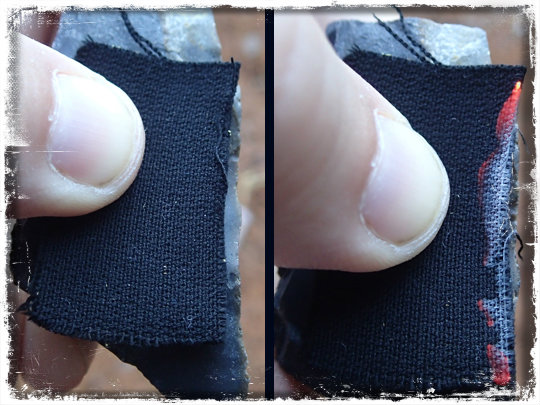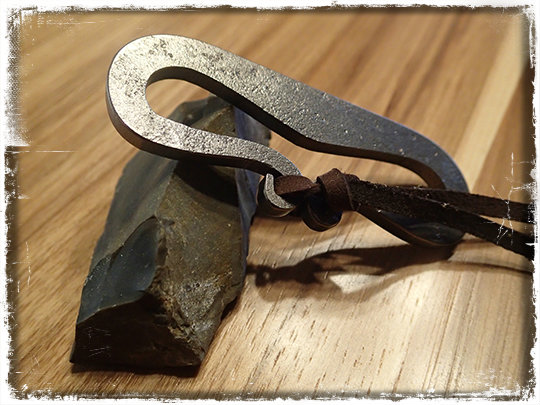
A friend of mine recently sent me a traditional medieval flint and steel fire making kit in a leather pouch.
This kit originates from a Russian gentleman who is both a craftsman and a blacksmith with a heritage of several generations. He produces handmade steel strikers and ready-to-use fire making kits for hunters, fishermen, travelers, historical re-enactors and other active people all over the world.
In his work he accurately renders such things as pouches and differently shaped steel strikers and knives, much like those found during archeological excavations. His works have become exhibits in a number of museums throughout Russia, Finland, Sweden, Germany and Australia.
They are frequently used to perform demonstrations and run workshops for kids and adult visitors alike. The craftsman runs his own site dedicated to flint and steel primitive fire making and offers delivery of his beautifully made kits worldwide. His works are also available on Etsy and eBay.
His works are very beautiful and from what I can tell after using the kit I received, they are very functional and reliable. They are useful tools as much as they are works of art and historical reconstruction. This means they can be used as real and reliable tools for fire making in the harsh conditions one can have to endure while hunting, traveling or living in the wilderness.
No matter what you use for fire making, a traditional kit like this is something everyone should have in their collection of fire making tools because this kit is a classic; it is the “grandfather” of all firemaking methods that we use nowadays, no matter whether we are talking about matches, gas lighters or modern firesteels.
A kit like this would also be a great gift for all active people and for those who like to gather with family and friends by the fireplace or to cook food over a fire.
Primitive Flint and Steel Kit 8.2
Let’s start with the contents of this beautifully crafted flint and steel kit.
- Steel Striker 3 Inches in Length
- Flint-3 Pieces
- Char Cloth In A Metal Tinder Box
- Two Bundles Of Jute Twine
- A High Quality Hand Crafted Leather Pouch To Carry It All, The Pouch Has leather Draw Strings To Keep All Contents Secured
First, this is not your typical flint and steel kit. Frankly, anyone can cobble together a piece of flint and steel, and some tinder, but this particular kit is by no means cobbled together.
Except for the jute twine and the tinder box, everything is hand crafted in a workshop. Not in some factory somewhere cranking out the kits by the hundreds or thousands. Each kit is made by hand, one at a time.
The material is made without the use of electricity, and without any mass production techniques. The craftsman believes in using techniques handed down through the generations, so the skills and techniques are preserved and passed down once again.
The kit is crafted with care. The steel is hand forged using age old techniques that had been handed down. The attention to detail is remarkable, right down to the type of wood used to heat the metal, and then tempering the metal in rainwater.
About The Char Cloth
The char cloth was carefully made and of excellent quality. I could see that right away. It was flawlessly made using unbleached linen, and the texture was perfect for handling without fear it would crumble in my hands. To make it, the craftsman placed the linen in a hermetically sealed earthenware jar and then placed it in a wood burning oven to scorch.

Char cloth, as many of you know is organic material that is reduced by heat to its carbon form. Char cloth is essential for fire starting when using flint and steel. The cloth must be able take a spark and create an ember. Poorly made char cloth may mean some cold nights in the wilds.
The flint, steel and the char cloth with this kit does not disappoint, because after a few strikes I had an ember glowing brightly. From that point it was simply a matter of feeding it some oxygen and some dry tinder, jute twine for example.
Flint and Steel
In years past people did not have extra linen or cotton material laying around the house. Linen and cotton were goods to be sold, bartered with, or worn, so given this, other things were used to make char. Usually charred plant material was carried in a tinder box along with flint and steel. Flint and steel were usually the only way to create a fire, because matches were either nonexistent, or were a luxury no one could afford.

Char cloth can be made from essentially any organic material. It is typically made from vegetable fibers such as cotton, jute, or linen. However, you can make char from punk wood, using husks from nuts, bark from trees, pine cones, certain moss and even birch fungi picked from dead birch trees is becoming another popular choice as well. The technique used would the same as if you were using cotton cloth or cotton balls.
Organics, once broken down by a process called pyrolysis will ignite at a lower temperature. Thermo chemical decomposition of organic material at elevated temperatures in the absence of oxygen is what reduces organic material down to its carbon form, in other words down to char.
You can make it at home, but we do not suggest you try sealing the cloth in an earthenware jar. You may want to leave that to the craftsman. The process will produce gases that have to escape, so for those making it at home use a sealed metal tin with a small vent hole in it.
Gases’ exiting the vent is what keeps oxygen from entering the tin through the vent hole. Once the gases stop venting, oxygen can then enter the tin causing the material to break completely down to ash. You have to monitor the process carefully.
The gases will have to be vented to keep the lid from popping off, and once this happens the material will burn completely away and could cause your fire to get out of control, safety first.
Layer the material in the tin and place on a fire. Make char cloth in a well ventilated area that allows for a safe fire. You will see smoke (gases) coming out of the hole as the material reduces, and once the smoke diminishes or stops altogether you then have char cloth. Sounds easy enough, but you will have to practice this technique a few times to get it just right, because it is quite easy to reduce the material to ash.
Before the introduction of steel, a variety of iron pyrite or marcasite was used with flint and/or other stones to produce a spark that could be used to create fire.
When flint and steel were used, the fire steel was often kept in a metal tinderbox together with flint and tinder. In Tibet and Mongolia however, they were carried in a leather pouch called a chuckmuck.